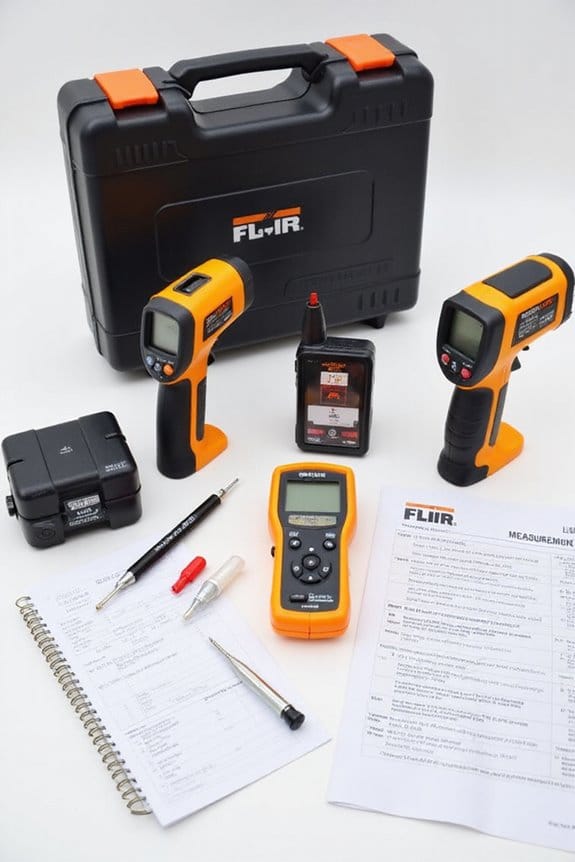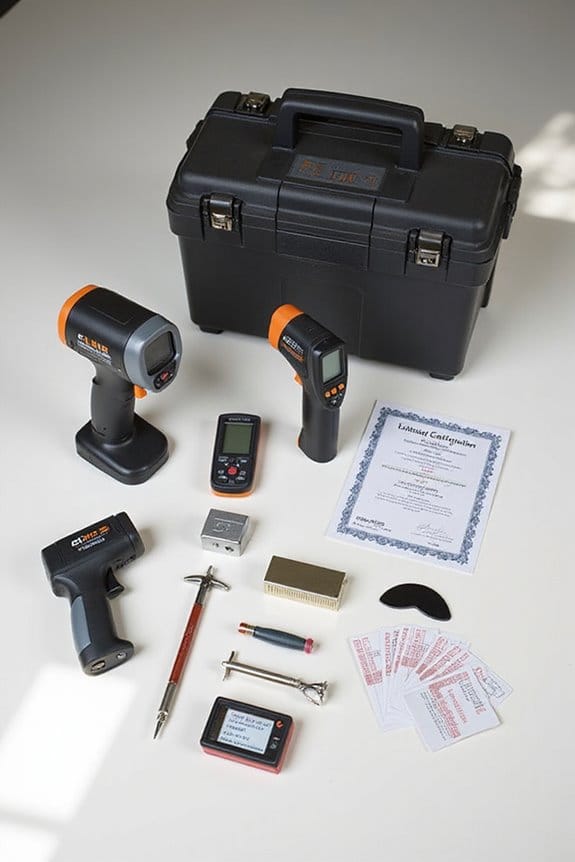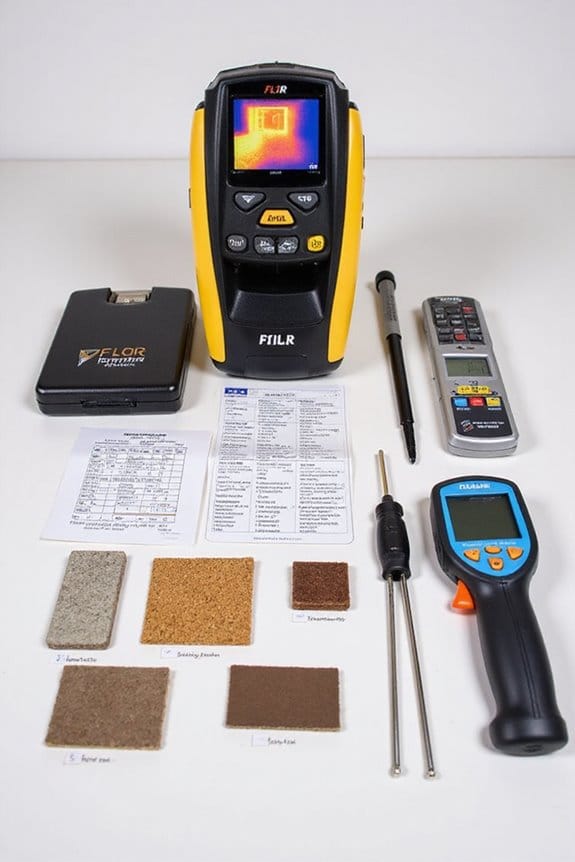When it comes to IR measurements, I often find that the maximum effective range is typically up to 100 feet for infrared pyrometers. However, this depends on a few factors like sensor quality and environmental conditions. For instance, a higher Distance-to-Spot (D:S) ratio can improve accuracy over long distances. Just remember, ensuring proper calibration and considering factors like target size is essential. Stick around to learn more about how to enhance your measurement accuracy!
Key Takeaways
- Most infrared pyrometers can measure effectively up to 100 feet (30 meters) depending on the model and conditions.
- Higher Distance-to-Spot (D:S) ratios, such as 20:1, allow for more accurate measurements over longer distances.
- Environmental factors like fog, dust, and rain can significantly reduce measurement accuracy at greater distances.
- Thermal cameras with higher resolutions and pixel densities improve detection capabilities for distant measurements.
- Short-range IR sensors have specific distance limits, ranging from just a few centimeters to about 2 meters depending on the model.
Understanding IR Thermometer Measurement Distances
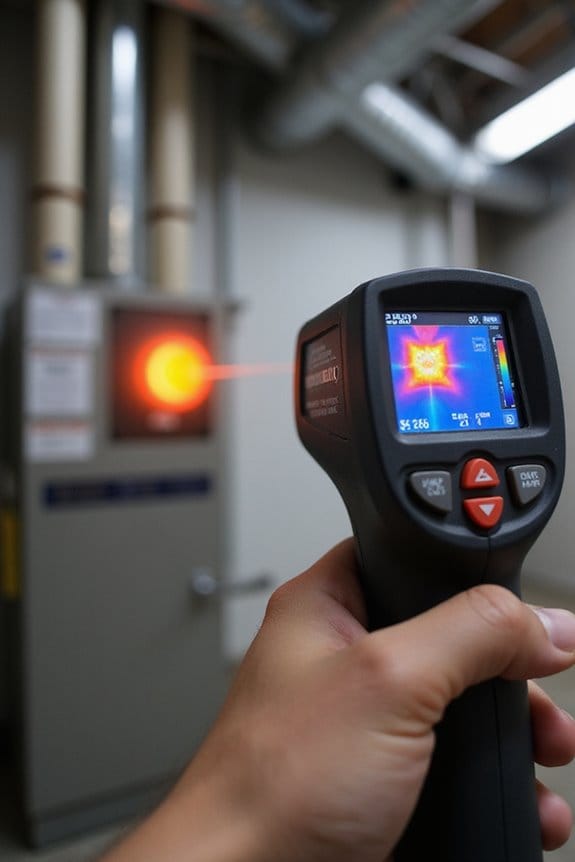
When it comes to using an IR thermometer, understanding measurement distances is essential—especially if you want accurate readings. Here’s what I’ve learned about it:
- Distance-to-Spot (D:S) Ratio: This ratio shows how far away you can be while still accurately measuring. For example, a 12:1 ratio means from 12 inches away, you measure a 1-inch spot.
- Calibration Techniques: Regular calibration guarantees your thermometer stays precise.
- Sensor Sensitivity: Higher sensitivity allows measurements from greater distances, but most standard models max out around 100 feet.
In short, always check your thermometer’s specifications. It’s a simple step that can save you from measurement mishaps—because nobody wants an inaccurate reading!
Factors Influencing Distance Limits in Thermal Cameras
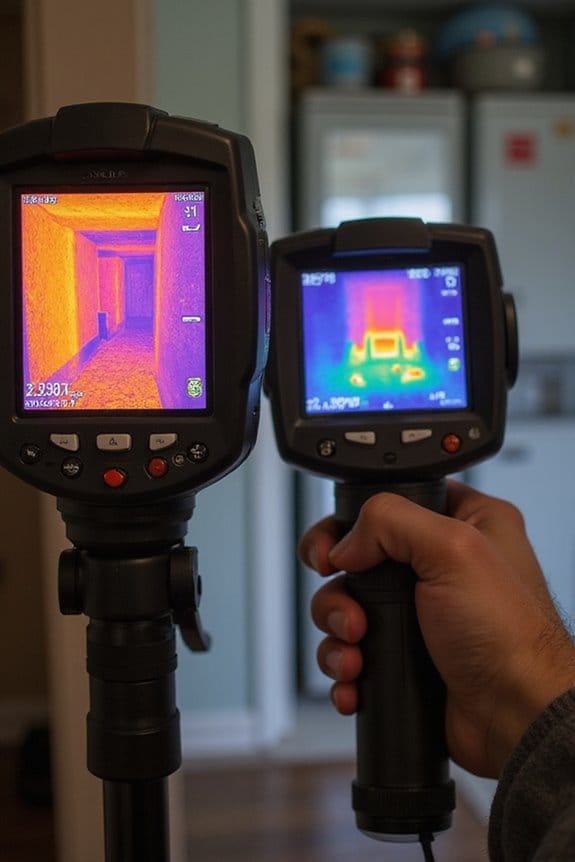
While using a thermal camera can be fascinating, it’s essential to understand the factors that influence how far away you can effectively measure temperatures. Here are the key points:
- Pixel Density: Higher pixel density means more details captured. It’s like having more breadcrumbs to follow on a trail—more pixels help you spot the target from a distance.
- Lens Quality: The quality of your lens matters. A narrow field of view can magnify distant objects, improving measurement accuracy. On the other hand, a wide lens might cover more area but sacrifices detail.
- Environmental Factors: Weather can play tricks on your readings. Fog or rain can scatter infrared signals, limiting your effective range. Additionally, higher resolutions in thermal cameras can enhance the ability to detect temperature differences from greater distances.
Infrared Pyrometer Measurement Distances
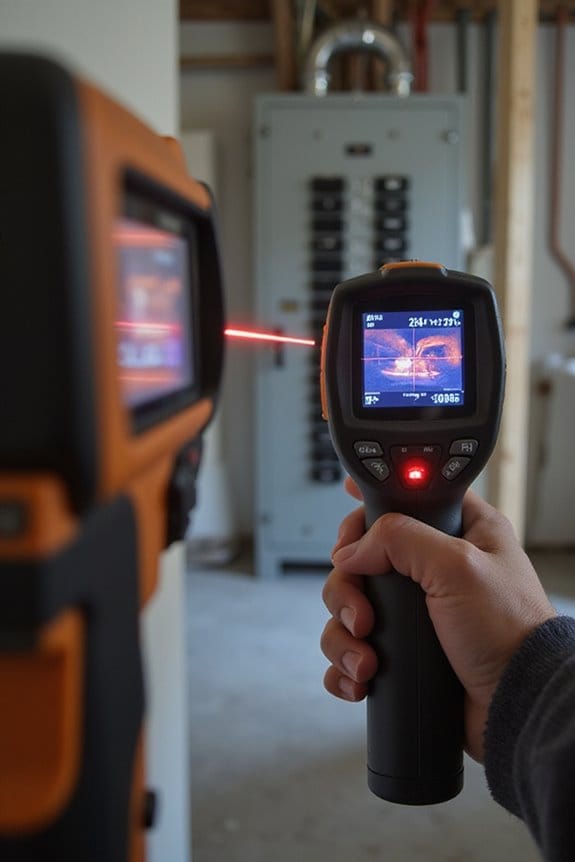
Understanding the maximum distances for infrared (IR) pyrometer measurements builds on the factors we’ve discussed before about thermal cameras. Here’s what I’ve found:
- Typical Range: Most IR pyrometers measure effectively up to 100 feet (30 meters) depending on conditions.
- Distance-to-Spot Ratio: A higher ratio (like 20:1) means better accuracy at longer distances.
- Spot Size Matters: The target must be larger than the spot size for accurate readings.
- Atmospheric Challenges: Dust and smoke can really mess with your readings, so keep that in mind.
Don’t forget about pyrometer calibration techniques to improve distance measurement accuracy! With the right approach, you can get reliable readings even at a distance—just be aware of your environment!
Short-Range IR Distance Sensor Ranges

Short-range IR distance sensors are fascinating devices that make proximity sensing both simple and effective. They typically cover ranges from about 2 cm to 2 meters. Here are a few sensor specifications and application examples:
- Very Short Distance Sensors: The Sharp GP2Y0A51SK0F detects from 2 cm to 15 cm. It’s perfect for small robotics.
- Short Distance Sensors: The Sharp GP2Y0A41SK0F operates between 4 cm and 30 cm, great for personal devices and sanitary applications.
- Moderate Short-Range Sensors: The Sharp GP2Y0A21YK0F measures from 10 cm to 80 cm, ideal where sonar sensors falter.
- ToF Technology: The REV Robotics 2m Distance Sensor uses Time-of-Flight tech, measuring from 5 cm to 200 cm, ensuring accuracy.
These sensors are compact and versatile, making them invaluable in various fields!
Distance to Spot Size Ratios and Resolution in IR Cameras

When it comes to infrared (IR) cameras, the distance to spot size (D:S) ratio is a key player in how accurately we can measure temperature from afar. Here’s what you need to know:
- D:S Ratio Basics: The D:S ratio tells us how far away we can measure a specific spot size. A higher ratio means better precision.
- Spatial Resolution: This depends on the D:S ratio and the camera’s instantaneous field of view (IFOV). Smaller IFOV means better resolution, letting us spot smaller objects at greater distances.
- Lens Matters: The type of lens affects both the D:S ratio and spatial resolution. Longer lenses can see further but might reduce the field of view.
Environmental and Practical Limitations on IR Measurement Distance
While you might think measuring temperature with infrared (IR) sensors is a breeze, several environmental and practical limitations can throw a wrench in the works. Here are some key factors to take into account:
- Atmospheric Conditions: Water vapor and gases can absorb IR radiation, reducing sensor effectiveness over distance.
- Interference Sources: Dust, smoke, or heat from nearby objects may scatter or distort the IR signals, leading to inaccurate readings.
- Physical Constraints: Line of sight and target accessibility matter. If something’s in the way, you won’t get a clear measurement.
In industrial settings, I often find that reliable readings are best achieved within a few meters. Keep these limitations in mind, and you’ll avoid unnecessary headaches!
The Importance of Target Size in Distance Measurement
Getting the right temperature readings with infrared (IR) sensors isn’t just about pointing and shooting; the size of your target plays a significant role in how accurate those measurements will be. Here’s why target size matters for measurement accuracy:
- Spot Size Growth: As you increase the distance, the sensor’s spot size enlarges. If your target’s smaller than this spot, you might pick up background temperatures—yikes!
- D:S Ratio: This ratio helps you understand how far you can be while still measuring accurately. For example, a 12:1 ratio means at 12 feet, your spot’s one foot wide.
- Calibration Standards: Following guidelines like ASTM E1256 guarantees your target size meets accuracy requirements.
Enhancing Accuracy in Long-Distance IR Measurements
To enhance accuracy in long-distance infrared (IR) measurements, it’s essential to take into account several factors that can influence the quality of your readings. Here are some tips:
- Use Ratio Pyrometers: They help assess temperature in varying conditions, even with signal reductions.
- Select Atmospheric Windows: These wavelength ranges minimize air absorption, improving signal integrity.
- Invest in High-Resolution Cameras: They boost accuracy at longer distances with better sensitivity and pixel density.
- Employ Signal Processing Techniques: Modulated IR systems can filter out noise, ensuring clearer readings.
- Optimize Optical Design: Specialized lenses can focus IR radiation, enhancing measurement range.
Frequently Asked Questions
Can IR Thermometers Measure Through Glass or Plastic Surfaces?
Imagine trying to glimpse a sunset through a foggy window. I’ve learned that IR thermometers struggle with glass interference and plastic absorption; they measure the surface, not the hidden warmth beyond. Keep that in mind!
How Does Temperature Affect IR Measurement Accuracy?
Temperature variations can greatly affect measurement reliability in infrared readings. I’ve noticed that if emissivity isn’t adjusted for different temperatures, accuracy drops, leading to potential errors that could misrepresent the actual surface temperature.
Are There Specific Materials That Reflect IR Measurements Poorly?
I’ve found that materials with low emissivity, like matte surfaces, absorb IR effectively, while polished metals reflect it poorly. Understanding these IR reflectivity factors and material absorption characteristics is essential for accurate temperature measurements.
What Maintenance Is Required for IR Measurement Devices?
Maintaining IR devices is like nurturing a delicate flower; it needs regular device care and calibration checks. I prioritize cleaning, calibration schedules, and documentation to guarantee accuracy and reliability in every measurement. It’s absolutely essential!
Can IR Sensors Be Calibrated for Specific Environmental Conditions?
Yes, I’ve found that IR sensors can be effectively calibrated using various calibration techniques tailored to environmental factors, ensuring accuracy even in challenging conditions like humidity or temperature fluctuations, which can considerably impact sensor performance.

